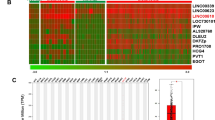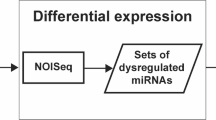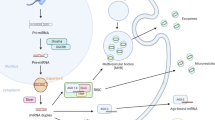Abstract
Human tumors are characterized by widespread reduction in microRNA (miRNA) expression, although it is unclear how such changes come about and whether they have an etiological role in the disease. Importantly, miRNA knockdown has been shown to enhance the tumorigenic potential of human lung adenocarcinoma cells. A defect in miRNA processing is one possible mechanism for global downregulation. To explore this possibility in more detail in vivo, we have manipulated Dicer1 gene dosage in a mouse model of retinoblastoma. We show that although monoallelic loss of Dicer1 does not affect normal retinal development, it dramatically accelerates tumor formation on a retinoblastoma-sensitized background. Importantly, these tumors retain one wild-type Dicer1 allele and exhibit only a partial decrease in miRNA processing. Accordingly, in silico analysis of human cancer genome data reveals frequent hemizygous, but not homozygous, deletions of DICER1. Strikingly, complete loss of Dicer1 function in mice did not accelerate retinoblastoma formation. miRNA profiling of these tumors identified members of the let-7 and miR-34 families as candidate tumor suppressors in retinoblastoma. We conclude that Dicer1 functions as a haploinsufficient tumor suppressor. This finding has implications for cancer etiology and cancer therapy.
Similar content being viewed by others
Log in or create a free account to read this content
Gain free access to this article, as well as selected content from this journal and more on nature.com
or
Abbreviations
- miRNA:
-
microRNA
References
Croce CM . Causes and consequences of microRNA dysregulation in cancer. Nat Rev Genet 2009; 10: 704–714.
Bartel DP . MicroRNAs: target recognition and regulatory functions. Cell 2009; 136: 215–233.
Ventura A, Jacks T . MicroRNAs and cancer: short RNAs go a long way. Cell 2009; 136: 586–591.
Esquela-Kerscher A, Trang P, Wiggins JF, Patrawala L, Cheng A, Ford L et al. The let-7 microRNA reduces tumor growth in mouse models of lung cancer. Cell Cycle 2008; 7: 759–764.
Kumar MS, Erkeland SJ, Pester RE, Chen CY, Ebert MS, Sharp PA et al. Suppression of non-small cell lung tumor development by the let-7 microRNA family. Proc Natl Acad Sci USA 2008; 105: 3903–3908.
Esquela-Kerscher A, Slack FJ . Oncomirs – microRNAs with a role in cancer. Nat Rev Cancer 2006; 6: 259–269.
Lu J, Getz G, Miska EA, Alvarez-Saavedra E, Lamb J, Peck D et al. MicroRNA expression profiles classify human cancers. Nature 2005; 435: 834–838.
Kumar MS, Lu J, Mercer KL, Golub TR, Jacks T . Impaired microRNA processing enhances cellular transformation and tumorigenesis. Nat Genet 2007; 39: 673–677.
Chang TC, Yu D, Lee YS, Wentzel EA, Arking DE, West KM et al. Widespread microRNA repression by Myc contributes to tumorigenesis. Nat Genet 2008; 40: 43–50.
Pampalakis G, Diamandis EP, Katsaros D, Sotiropoulou G . Down-regulation of dicer expression in ovarian cancer tissues. Clin Biochem 2009; e-pub ahead of print 25 September 2009.
Karube Y, Tanaka H, Osada H, Tomida S, Tatematsu Y, Yanagisawa K et al. Reduced expression of Dicer associated with poor prognosis in lung cancer patients. Cancer Sci 2005; 96: 111–115.
Melo SA, Ropero S, Moutinho C, Aaltonen LA, Yamamoto H, Calin GA et al. A TARBP2 mutation in human cancer impairs microRNA processing and DICER1 function. Nat Genet 2009; 41: 365–370.
Bernstein E, Kim SY, Carmell MA, Murchison EP, Alcorn H, Li MZ et al. Dicer is essential for mouse development. Nat Genet 2003; 35: 215–217.
Murchison EP, Partridge JF, Tam OH, Cheloufi S, Hannon GJ . Characterization of Dicer-deficient murine embryonic stem cells. Proc Natl Acad Sci USA 2005; 102: 12135–12140.
Rowan S, Cepko CL . Genetic analysis of the homeodomain transcription factor Chx10 in the retina using a novel multifunctional BAC transgenic mouse reporter. Dev Biol 2004; 271: 388–402.
Damiani D, Alexander JJ, O’Rourke JR, McManus M, Jadhav AP, Cepko CL et al. Dicer inactivation leads to progressive functional and structural degeneration of the mouse retina. J Neurosci 2008; 28: 4878–4887.
Zhang J, Schweers B, Dyer MA . The first knockout mouse model of retinoblastoma. Cell Cycle 2004; 3: 952–959.
Donovan SL, Schweers B, Martins R, Johnson D, Dyer MA . Compensation by tumor suppressor genes during retinal development in mice and humans. BMC Biol 2006; 4: 14.
Zhang J, Gray J, Wu L, Leone G, Rowan S, Cepko CL et al. Rb regulates proliferation and rod photoreceptor development in the mouse retina. Nat Genet 2004; 36: 351–360.
DiCiommo D, Gallie BL, Bremner R . Retinoblastoma: the disease, gene and protein provide critical leads to understand cancer. Semin Cancer Biol 2000; 10: 255–269.
Laurie NA, Donovan SL, Shih CS, Zhang J, Mills N, Fuller C et al. Inactivation of the p53 pathway in retinoblastoma. Nature 2006; 444: 61–66.
Marine JC, Dyer MA, Jochemsen AG . MDMX: from bench to bedside. J Cell Sci 2007; 120 (Pt 3): 371–378.
Dyer MA, Cepko CL . p27Kip1 and p57Kip2 regulate proliferation in distinct retinal progenitor cell populations. J Neurosci 2001; 21: 4259–4271.
Yuge K, Nakajima M, Uemura Y, Miki H, Uyama M, Tsubura A . Immunohistochemical features of the human retina and retinoblastoma. Virchows Arch 1995; 426: 571–575.
Alexiades MR, Cepko CL . Subsets of retinal progenitors display temporally regulated and distinct biases in the fates of their progeny. Development 1997; 124: 1119–1131.
Liu IS, Chen JD, Ploder L, Vidgen D, van der Kooy D, Kalnins VI et al. Developmental expression of a novel murine homeobox gene (Chx10): evidence for roles in determination of the neuroretina and inner nuclear layer. Neuron 1994; 13: 377–393.
Burmeister M, Novak J, Liang MY, Basu S, Ploder L, Hawes NL et al. Ocular retardation mouse caused by Chx10 homeobox null allele: impaired retinal progenitor proliferation and bipolar cell differentiation. Nat Genet 1996; 12: 376–384.
Bussing I, Slack FJ, Grosshans H . let-7 microRNAs in development, stem cells and cancer. Trends Mol Med 2008; 14: 400–409.
He L, He X, Lowe SW, Hannon GJ . microRNAs join the p53 network—another piece in the tumour-suppression puzzle. Nat Rev Cancer 2007; 7: 819–822.
Forbes SA, Bhamra G, Bamford S, Dawson E, Kok C, Clements J et al. The catalogue of somatic mutations in cancer (COSMIC). Curr Protoc Hum Genet 2008; Chapter 10 Unit 10 11.
Hill DA, Ivanovich J, Priest JR, Gurnett CA, Dehner LP, Desruisseau D et al. DICER1 mutations in familial pleuropulmonary blastoma. Science 2009; 325: 965.
Kumar MS, Pester RE, Chen CY, Lane K, Chin C, Lu J et al. Dicer1 functions as a haploinsufficient tumor suppressor. Genes Dev 2009; 23: 2700–2704.
Santarosa M, Ashworth A . Haploinsufficiency for tumour suppressor genes: when you don’t need to go all the way. Biochim Biophys Acta 2004; 1654: 105–122.
Huang JC, Babak T, Corson TW, Chua G, Khan S, Gallie BL et al. Using expression profiling data to identify human microRNA targets. Nat Methods 2007; 4: 1045–1049.
Dalgard CL, Gonzalez M, deNiro JE, O’Brien JM . Differential microRNA-34a expression and tumor suppressor function in retinoblastoma cells. Invest Ophthalmol Vis Sci 2009; 50: 4542–4551.
MacPherson D, Conkrite K, Tam M, Mukai S, Mu D, Jacks T . Murine bilateral retinoblastoma exhibiting rapid-onset, metastatic progression and N-myc gene amplification. EMBO J 2007; 26: 784–794.
Lee WH, Murphree AL, Benedict WF . Expression and amplification of the N-myc gene in primary retinoblastoma. Nature 1984; 309: 458–460.
Mestdagh P, Van Vlierberghe P, De Weer A, Muth D, Westermann F, Speleman F et al. A novel and universal method for microRNA RT-qPCR data normalization. Genome Biol 2009; 10: R64.
Mestdagh P, Feys T, Bernard N, Guenther S, Chen C, Speleman F et al. High-throughput stem-loop RT-qPCR miRNA expression profiling using minute amounts of input RNA. Nucleic Acids Res 2008; 36: e143.
Acknowledgements
We thank Natalie Farla and Rose Van Isacker for their excellent technical assistance. We thank G Hannon for providing the Dic floxed mince. J-C Marine received support from the EMBO Young Investigator program. This work was supported in part by Geconcerteerde Onderzoek Aangelegenheden (GOA, University Ghent, Belgium) and EU (FP7 Program, ONCOMIRs, Contract no. 201102). This publication reflects only the authors’ views. The commission is not liable for any use that may be made of the information herein.
Author information
Authors and Affiliations
Corresponding author
Additional information
Edited by G Melino
Rights and permissions
About this article
Cite this article
Lambertz, I., Nittner, D., Mestdagh, P. et al. Monoallelic but not biallelic loss of Dicer1 promotes tumorigenesis in vivo. Cell Death Differ 17, 633–641 (2010). https://doi.org/10.1038/cdd.2009.202
Received:
Accepted:
Published:
Issue date:
DOI: https://doi.org/10.1038/cdd.2009.202
Keywords
This article is cited by
-
APE1 controls DICER1 expression in NSCLC through miR-33a and miR-130b
Cellular and Molecular Life Sciences (2022)
-
microRNAs: New-Age Panacea in Cancer Therapeutics
Indian Journal of Surgical Oncology (2021)
-
Cancer-associated mutations in DICER1 RNase IIIa and IIIb domains exert similar effects on miRNA biogenesis
Nature Communications (2019)
-
nc886 is induced by TGF-β and suppresses the microRNA pathway in ovarian cancer
Nature Communications (2018)
-
Beyond DNA: the Role of Epigenetics in the Premalignant Progression of Breast Cancer
Journal of Mammary Gland Biology and Neoplasia (2018)



